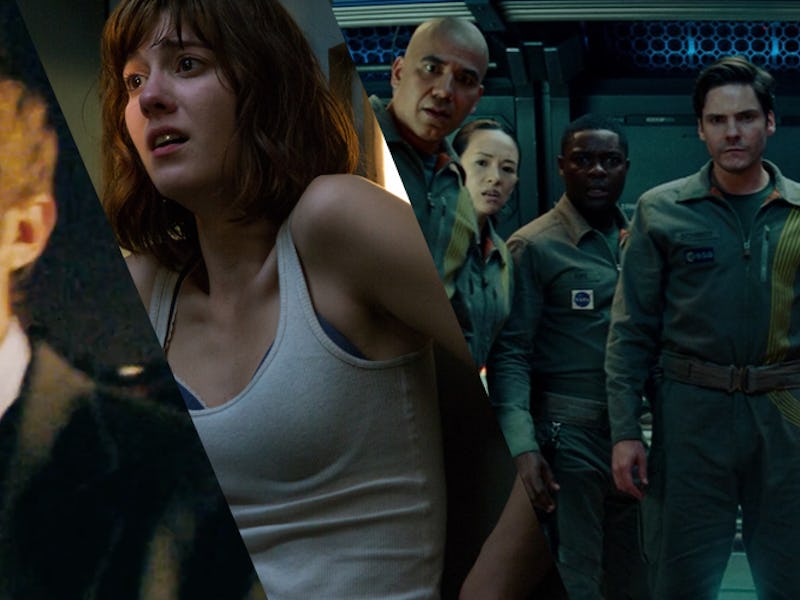How ‘The Cloverfield Paradox’ Easter Eggs Connect to the Rest of the Series
A ten-year mystery may have finally been answered for fans of the monster horror franchise.

Shortly after the Eagles somewhat unexpectedly defeated the Patriots at the Super Bowl on Sunday, Netflix unexpectedly released The Cloverfield Paradox, the third film in J.J. Abrams’s Cloverfield anthology. Directed by Julius Onah and starring an ensemble cast including Gugu Mbatha-Raw (Jupiter Ascending), Daniel Brühl (Captain America: Civil War), and David Oyelowo (Selma), The Cloverfield Paradox finally answers some of the biggest mysteries left unsolved by the original movie, 2008’s Cloverfield, a Godzilla film by way of YouTube.
Although it’s a loosely-connected series, The Cloverfield Paradox features many more explicit connections to the other films than 2016’s 10 Cloverfield Lane, did. In The Cloverfield Paradox, researchers aboard an international space station experiment with a “God Particle” — a real thing in particle physics — and unwittingly unleash a horrible nightmare.
It’s been a long, long time since May 22, 2008, the night of Rob’s going away party in New York, which served as the backdrop to the first Cloverfield (there’s a timestamp in the video tape). However, eagle-eyed viewers who still remember the night a monster was let loose in midtown will be pleasantly surprised at the Easter eggs in Cloverfield Paradox that connect the series as a whole.
For those curious how all these threads tie together, here is how The Cloverfield Paradox connects to Cloverfield and even bits of 10 Cloverfield Lane.
Spoilers for The Cloverfield Paradox ahead.
Homeboy is back. From 'The Cloverfield Paradox.'
The Monster Returns!
Of course the biggest connection, between The Cloverfield Paradox and the first Cloverfield, quite literally, is the “Cloverfield monster,” who roars back in the very last frame of Paradox. And, yes, it’s the same monster from the first film that ruined Rob’s party. He looks good after ten years.
Look to the left of the boat. What splashed down? Fans have been speculating the end of 2008's 'Cloverfield' for a decade.
The Falling Satellite Theory, Solved
One of the biggest mysteries that has eluded fans for a decade was the ending to the original Cloverfield. As fans remember, that original film was being played off a faulty Hi-8 camcorder — it was 2008, remember?— where it was still possible to “record over” video. Hud (T.J. Miller), Rob’s friend taping the party, was accidentally recording over Rob’s Coney Island date with his ex-girlfriend. (The pair presumably die together under the bridge in Central Park).
At the end of Cloverfield, in the last bits of tape showing Rob’s date on the ferris wheel, there’s an unidentified object that falls into the ocean off into the shore. It’s barely visible, but fans have been watching it closely for years. Finally, after ten years, The Cloverfield Paradox reveals what it was: The Shepard, torn apart, containing Eva (Gugu Mbatha-Raw) and Schmidt (Daniel Brühl). At the end of Paradox, the Shepard falls into the ocean while the monster roars.
Slusho continues to mystify in 2018's 'The Cloverfield Paradox.'
Slusho!
Think of the most radioactive Slurpee from 7-Elevent: That’s Slusho, the fictional frozen drink manufactured in Japan that has an insidious presence in every Cloverfield film. (It’s even got cameos in TV shows like Lost, Heroes, and the reboot Stark Trek trilogy.) In The Cloverfield Paradox, a Slusho bobblehead rests atop a console, ominously shaking when the crew fire off their experiment after two years.
In the original Cloverfield, Slusho hired Rob (Michael Stahl-David) to work in Japan — hence why Rob’s friends threw him a going-away shindig. But that’s when the “Cloverfield monster” strikes, spiraling Rob’s party into a horrible nightmare of survival.
One of the most popular fan theories that endured for years after Cloverfield was that Slusho, whose parent company was the (also fictional) drilling company Tagruto, created the monster after dumping toxic waste into the Pacific Ocean. That origin calls back to Godzilla’s, a lizard exposed to nuclear radiation via weapons tests in the ocean.
In 10 Cloverfield Lane, John Goodman’s deranged doomsday prepper Howard was an employee of Tagruto. His profile used to be available on Tagruto’s staff page, which has been mysteriously destroyed. Below is what the staff page on Tagruto.jp used to look like, featuring John Goodman’s character.
Here’s what it looks like now, after the release of The Cloverfield Paradox:
The Bunker
More of a recurring theme than an actual connecting Easter egg, Michael — who finds a little girl in the rubble — find shelter in an unused bunker made by his friend, an off-screen individual named Peter. This isn’t John Goodman’s character, who again, was named Howard. But two films in a row that have characters in a bunker? It’s a thing.
But does it all connect?
A wrench in all this connective tissue are two things: The timeline, and the existence of a multiverse.
The Cloverfield Paradox features two parallel worlds that are set ten years from now in 2028, as confirmed through the decoded press release on the Tagruto website. That puts Paradox a whole twenty years after the first Cloverfield. So how could the Shepard fall into the ocean, and how could there be a monster when it’s been more than two decades after Rob’s party?
Because of how wonky the timelines are, it is possible we’re dealing with separate worlds. Maybe the Shepard has fallen in another world, a third world, which happens to be one set in Rob’s time of 2008. And the God Particle maybe released not one, but two monsters across worlds.
But even then, Eva’s husband Michael learns that the Shepard is returning to Earth’s orbit, which causes him to freak out, because, you know, there’s a monster. So what’s going on?
Suffice to say, just as the first two films, there are more questions than answers left after The Cloverfield Paradox.
The Cloverfield Paradox is streaming now on Netflix.